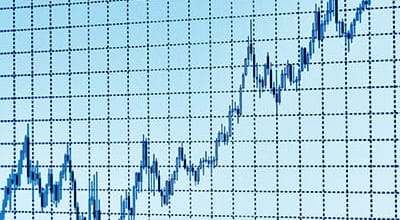Following several years of relative economic stability in the UK under the coalition government following the financial crisis, economic volatility is back.
A barrage of global events over the last five to seven years – the 2016 Brexit vote, Trump's election in the US and the ensuing US/China tensions, the COVID-19 pandemic, the Ukraine/Russia conflict – has caused economic shock after economic shock. The result reads like an economist’s worst nightmare; energy market crises, widespread inflation, rising interest rates, and lots of economic uncertainty. We even have a name for it – a perma-crisis.
Peter Arnold, Chief Economist at EY, says the scale and pace of economic disruption is unprecedented: “Certainly, over the last two years post pandemic, things are moving far more rapidly than economists are used to.” At the beginning of 2021, concerns about deflation were rife alongside projections that central banks would need to start cutting interest rates.
Today we're in the grip of an inflationary crisis that will really hurt consumers, Arnold warns. At time of writing, inflation stands at 10% in the UK and Europe and 9% in the US. In response, central banks are raising interest rates, which means higher costs of borrowing. One economic shock might be considered unfortunate, but to have so many in such close succession leaves the economy on shaky ground.
Lockdowns may be a distant memory, but the economic aftereffects of the pandemic are still to play out, Arnold warns. For some businesses, the pandemic highlighted the vulnerability of global supply chains and an overreliance on China and the Asian markets. Arnold notes that the pandemic “prompted questions around supply chain resilience, the need to mitigate supply chain risk and bring it closer to home, albeit at a cost.”
Volatile labour markets are another pandemic byproduct. Many workers in industries that effectively shut down during the pandemic changed jobs. “As economies reopened, we saw this big surge in demand but the labour supply wasn't there,” says Arnold. In the UK alone, there are currently around 500,000 fewer people in work than before the pandemic, driven by a big increase in inactivity, particularly those in the 50-plus demographic choosing to opt out of the labour market. The mismatch has driven wages up, which has also fed into inflation.
Hybrid working is seen as a positive for many employees but that has created its own challenges and uncertainties for business. With a typical London commuter in their office just 1.4 days a week according to consultancy Advanced Workplace Associates (AWA), employers are concerned about team engagement, productivity and learning and developing.
Energy prices were already rising before the Russian invasion of Ukraine created further volatility in energy markets. Policymakers, meanwhile, are grappling with the need to balance affordable energy for consumers and businesses with security of energy supply and meeting net zero objectives, the so-called energy trilemma.
In isolation, any one of the energy, supply chain and labour crunch issues creates huge volatility but together they are a perfect storm, Arnold says. “None of those are going to alleviate any time soon, so it does feel that ongoing volatility is now built into the system, and it will take some time to unwind before we exit this new normal.”
If the pandemic taught us anything, it is the ability of business to respond to changing circumstances. We saw first-hand the resilience and agility of businesses through COVID-19 and their ability to respond effectively and rapidly to the demands of the pandemic – those shifting workforces to homeworking almost oversight, food producers and supermarkets adjusting to changes in spending behaviour, retailers adopting online channels, health and life sciences companies generating treatments and vaccines in record time.
But ultimately uncertainty makes it hard to do business. “If you're going to make a five, 10, 15-year investment, then you want some certainty that you're going to get a return. Things like volatility in inflation, prices and interest rates means that the kind of assumptions you built business cases on maybe two or three years ago are now no longer valid. That level of uncertainty acts as a barrier to future business action.”
Economic forecasting is an art, not a science, but Arnold admits that the job has been incredibly difficult over the past 24 months. “If I look at forecasts from March this year, our expectations around inflation and economic activity were too optimistic, and people have constantly been revising them downwards. It points to the need for thinking around scenarios rather than thinking around a single economic forecast.”
“Two or three years ago, we'd say base case is probably within 70/80% probability. Now we would say base case is, let's say, 50% probability. Then you need to think about the balance of risk, most of which is to the downside. If I take the UK economy, the base case is we are likely to face a recession over the winter, high inflation and interest rates rising and, over the course of next year, the economy will recover, inflation will fall, and perhaps interest rates start to come down.”
One downside is higher and longer inflation and weak activity (stagflation). The other risks are further escalation in Ukraine and other geopolitical events, China's zero COVID-19 approach causing another lockdown or a more severe US recession – all of which could lead to a more severe economic downturn in the UK and Europe. Conversely, a possible upside could be an increase in geopolitical stability that brings gas and oil prices down, increases confidence and aids investment and consumer spending recovery.
Arnold’s advice to businesses looking to navigate uncertainty is to build scenarios into their business planning and be flexible enough to respond to them. Organisations also need to understand their exposure under different scenarios, in terms of both costs and revenue and to think about what they can do about it.
“Where are you most vulnerable to inflation? What are your input costs? How can you manage your costs down so you minimise exposure? It’s also about understanding customers. If you play mainly to a high-income consumer group, you're probably less vulnerable. Is the product you offer an essential or a luxury item where you're going to get the biggest demand impacts from higher prices? And then you need to think about your pricing strategy holistically; where can you afford to raise prices? Are you going to just destroy demand if you push your prices too high?”
The fact that finance teams own the numbers makes them well placed to help organisations weather the storm. “They should be the ones that own the analysis,” Arnold says. “Then they need to work with other functions within the organisation to think about how they best deal with the crunch they’re facing on their cost base, and the revenue challenges from consumers.”
Jumpstarting the Economy
Supply chain challenges, rising energy costs and global volatility are threatening to kickstart a recession. However, we examine the changes in technology, education and economic markets which could help keep the country on track.




